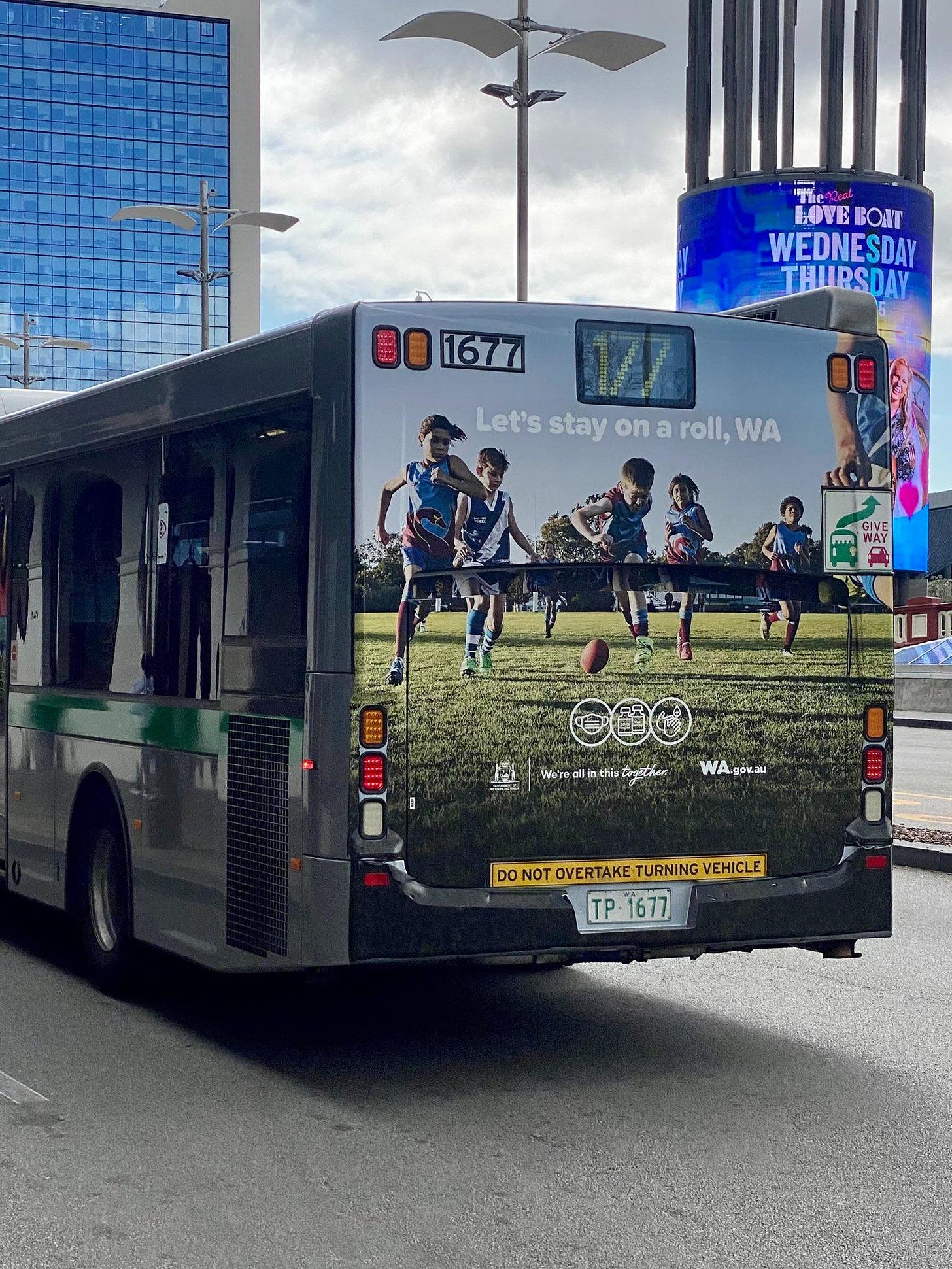A textual analysis of WA Gov’s “Let’s stay on a roll” campaign

We know that the risks of Covid vaccines outweigh the benefits for children. The UK has withdrawn approval for children under 11 to receive them. Denmark doesn’t even let adults under 50 get them anymore (except in special circumstances). Yet here is WA Gov using tax payer money to push them for kids:
This ad, part of a series in WA Gov’s “Let’s stay on a roll” campaign, promotes the holy trinity of WA’s public health strategy: Vaccination, Masking, and Hand Hygiene.
A textual analysis:
- The outdoor setting and sporting activity connotes freedom, health and connectedness. The implication being that staying “on a roll” with masking, vaccination and hand washing will afford more health, outdoor opportunities and social connection.
- The use of kids as the subject of this ad highlights the need for children to “stay on a roll”. Paired with the slogan, “We’re all in this together”, the secondary implication is that we must all stay on a roll to help each other, especially the children in our community. The reader can infer that in doing these things (vaccinating, masking, hand sanitising), we are somehow helping our community, especially kids.
- For adults, “staying on a roll” implies receiving more and more booster shots as they become available (this reading is supported by THIS PAGE on the campaign website, which states, “The COVID-19 fourth dose is available and encouraged for anyone aged 30 and over.” At present, ATAGI acknowledges that, as Covid variants evolve, we cannot expect to see effects on infection and transmission from further vaccination. Regarding severity of illness or death for those infected with the dominant Omicron subvariants BA.4 and BA.5, ATAGI recently stated that their fourth dose recommendation is based on inference, not evidence: “Data on correlation to clinical protection is not yet available but higher neutralising antibody levels are expected to provide some increase in protection.” BA.5 is the dominant strain in Australia at present.
- Juxtaposition of the slogan “We’re all in this together” with the team sport image implies that to “stay on a roll” (a winning streak) by continuing to mask, get more shots, and hand sanitise, you are a team player. Conversely, if you do not continue to do these things, you are not a team player, and your winning streak will lapse. This sets up the framing premise for WA’s future outcomes with regard to our community’s Covid outcomes: if WA sees a reduction in cases, hospitalisations and deaths, it is due to the efforts of ‘team players’ in staying on a roll. If WA sees a worsening in cases, hospitalisations and deaths, it is because people let the team down by not do their part (ie: getting more shots, wearing masks and hand sanitising).
- At least 2 of the 3 interventions featured in the ad (masking and vaccination) are established to have a negligible effect on transmission of SARS-CoV-2.
- This is a disease that predominantly affects the aged and infirm. By foregrounding children in this campaign, WA Gov shifts the focus away from the vulnerable and onto those who can neither benefit themselves nor provide any benefit to others by masking and vaccinating. Further, children are likely the most at risk from both of these interventions due to the asymmetry of the risk/benefit profile for kids.
In conclusion, this ad reads as misleading and dangerous, and signals misuse of tax payer funds. WA Gov strongly implies that certain interventions will improve health outcomes for children and the wider community, when the scientific evidence is either lacking or suggests otherwise. WA Gov puts children at risk by implying that children will benefit from vaccinations that are known to have a high risk:benefit ratio for this age group. WA Gov’s use of public funding to promote a message that is scientifically unsupported and that puts children at risk shows poor judgement in the management of the public purse. These monies should have been directed towards promoting behaviours and interventions that are scientifically supported and which will improve the safety and health of the community.
Source – https://rebekahbarnett.substack.com/p/a-textual-analysis-of-wa-govs-lets
